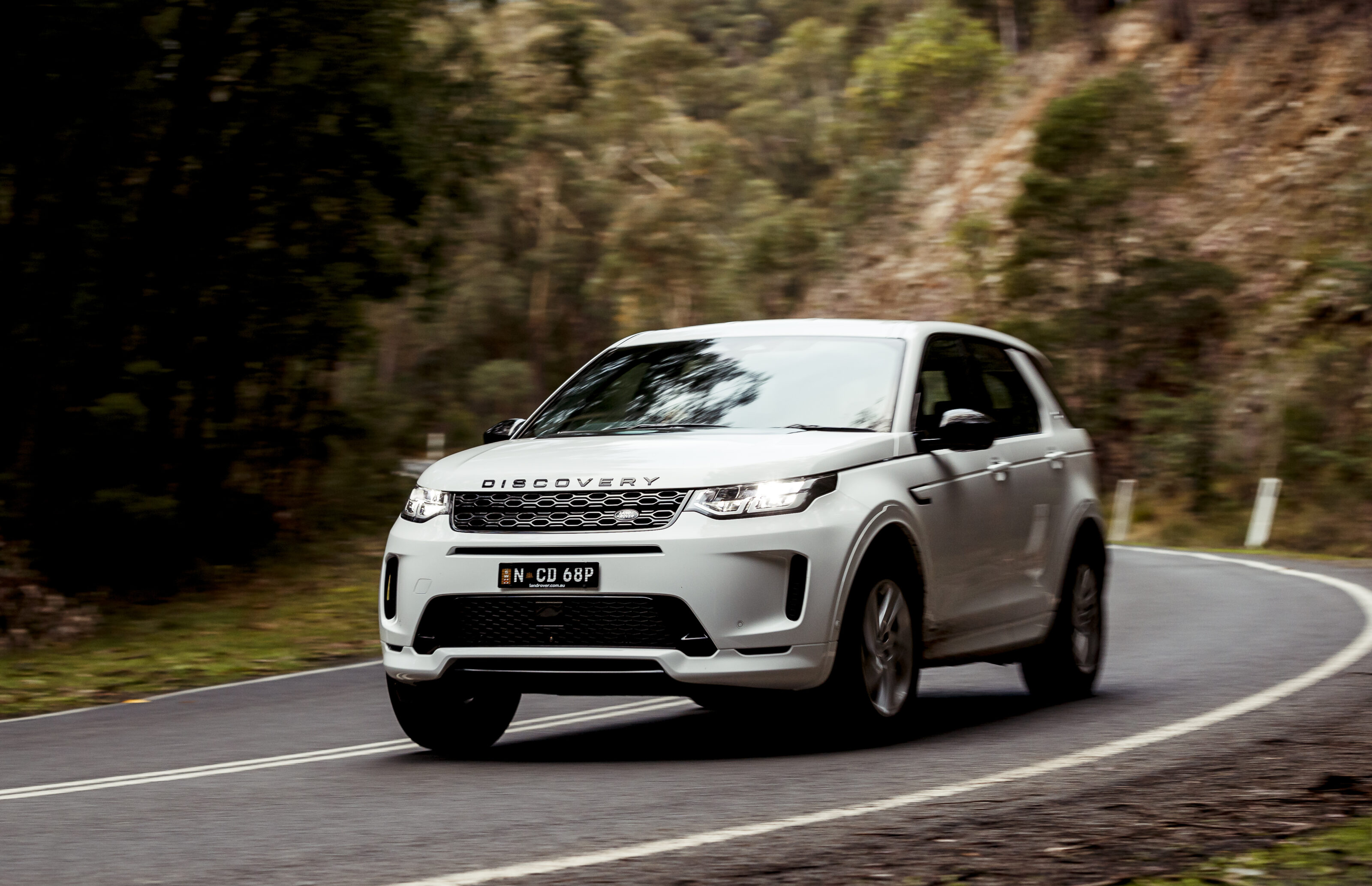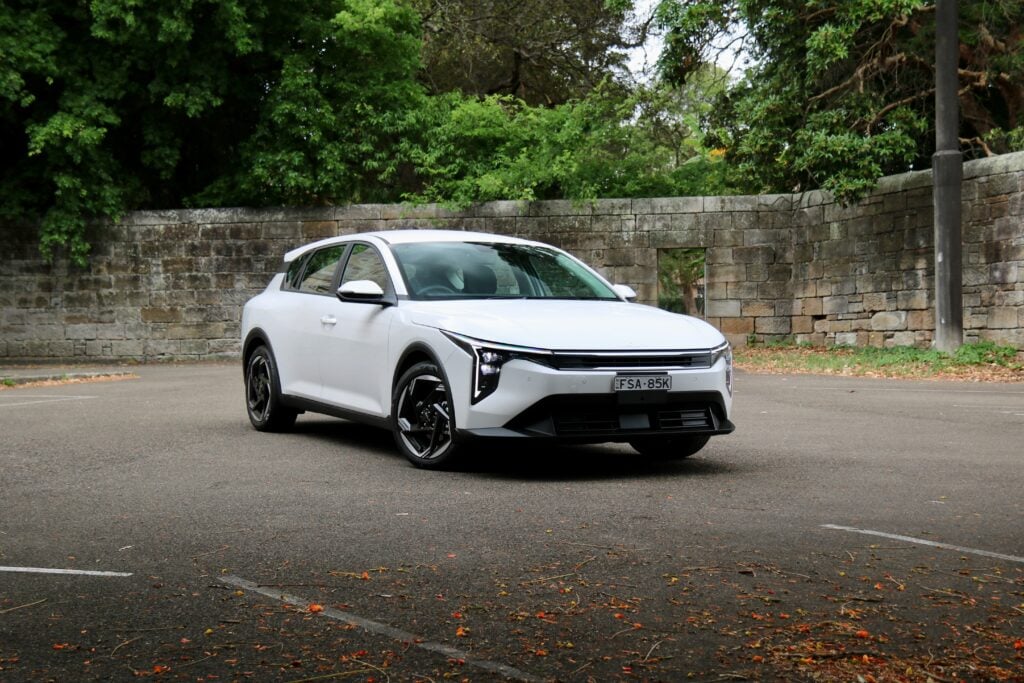Score breakdown
Things we like
- Lots of boot space – especially with third row down
- Smooth and comfortable drive
- 3D surround camera
Not so much
- Some options should be standard
- Transmission slow to react to input
- Third row a bit claustrophobic
Jaguar Land Rover has been busy improving its Land Rover Discovery Sport range with a series of recent updates – and for the 2021 model year, it culled variants and introduced new engines.
But here’s the thing – there’s already an MY22 update on the way, so what do you do? We’ve jumped into an MY21 Disco Sport to see if it’s worth considering, or whether you should wait for the newer model due to land on our shores any day now.
The 2021 Disco Sport is all about being more eco-friendly, with old diesel donks dropped in favour of new, more fuel-efficient options on offer – while also being comfy enough to keep the family happy on long journeys.
JLR has dropped the range of variants down from 10 to just five – dramatically reducing the number of diesels from six to two, both 48V mild hybrids. The Disco still sits on the same platform it moved to in 2020, which also underpins the Evoque.
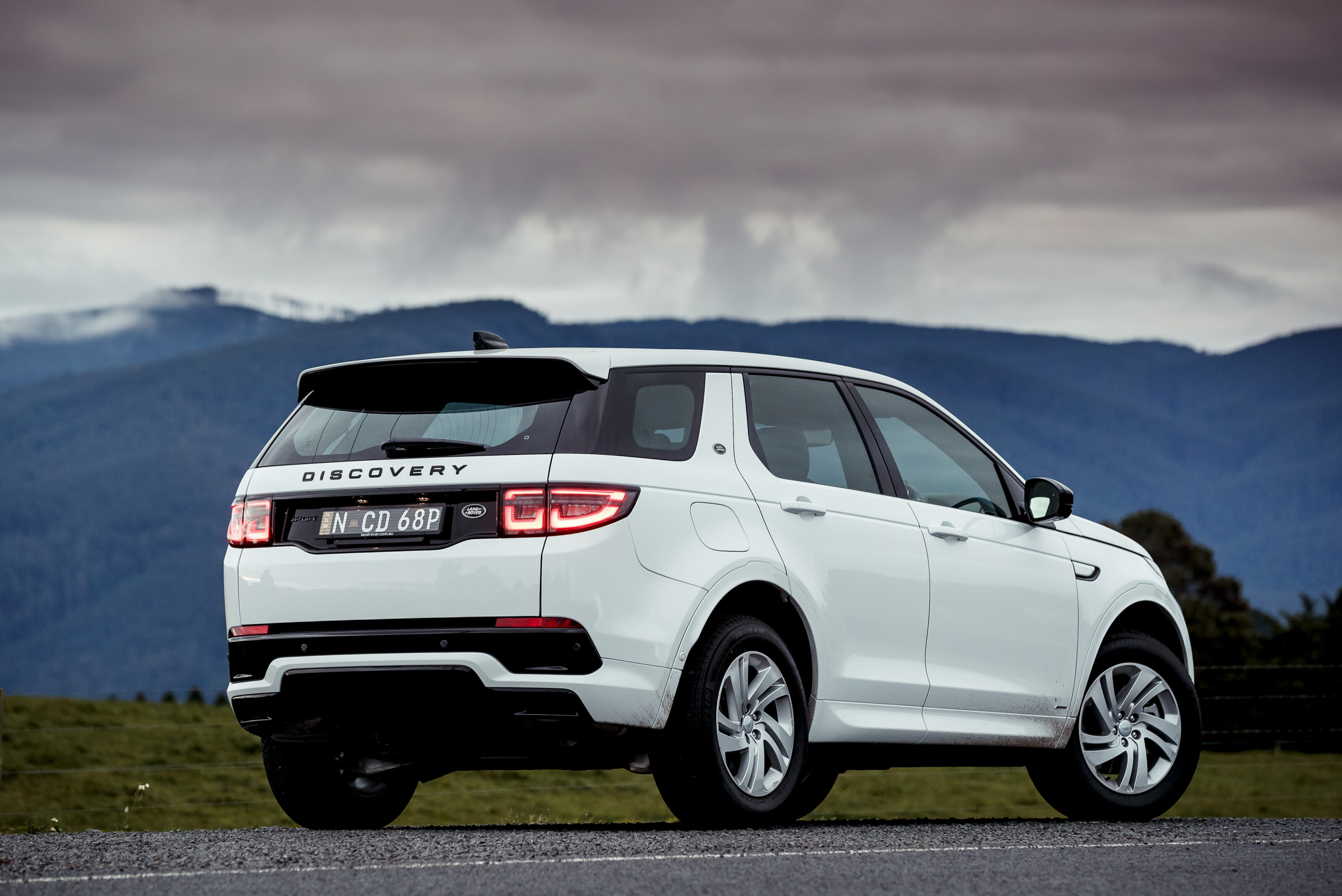
As a quick recap, the model was last overhauled with a mid-life update in 2019 for the MY20, taking influence from its Discovery sibling and Range Rover cousin.
On the face of it, the MY21 is an update and there’s not a whole lot that’s new compared to the 2020 model.
All the exterior gets is new LED headlights front and rear, as well as redesigned bumpers introduced with the previous version, but it’s inside where the differences are truly felt.
All variants, including the entry-level R-Dynamic S P200 variant in Fuji white we’re testing here, now benefit from a new, reasonably responsive, Pivi and Pivi Pro 10-inch infotainment system designed to be more intuitive for users – as well as Spotify integration (with data included) and over-the-air updates all as standard.
But it’s the 3D surround camera and cabin air filtration system we’re really impressed by. Both features offer the huge benefit of peace of mind for families.
Pricing

The Land Rover Discovery Sport range starts at $65,700 for the entry-level S P200 before on-road costs – which is the petrol model we’re reviewing here – though with the options mentioned it comes in at $68,070 MSRP.
The lowest-spec S D165 diesel is only a touch more expensive at $68,000 MSRP, the mid-spec SE P250 and SE D200 cost $74,076 and $75,610 respectively, while the range-topping HSE P250 sets buyers back $78,432. All five variants can now be found in R-Dynamic guise.
All variants benefit from a new Pivi and Pivi Pro 10-inch infotainment system designed to be more intuitive for users – as well as Spotify integration and over-the-air updates as standard.
Features

In the cabin, the materials, including door-cards, dash and Light Oyster padded headlining, look and feel immensely premium. The Ebony Luxtec and Suedecloth seats are soft and comfortable – even outclassing more expensive rivals in our opinion.
The twin-trimmed, part-perforated leather steering wheel is classy and has a pleasingly thin rim, while the Mars Red stitching across the dashboard and seats is a simple and tasteful injection of colour.
On the subject of doors, they are incredibly heavy. Although you could say it suggests good build quality, in practice they can be hard to keep open – which can make getting children in and out of the back seats slightly tricky. How many parents have struggled to get their little one out of a car seat while having a car door falling against their back? We’d hazard a guess at too many.
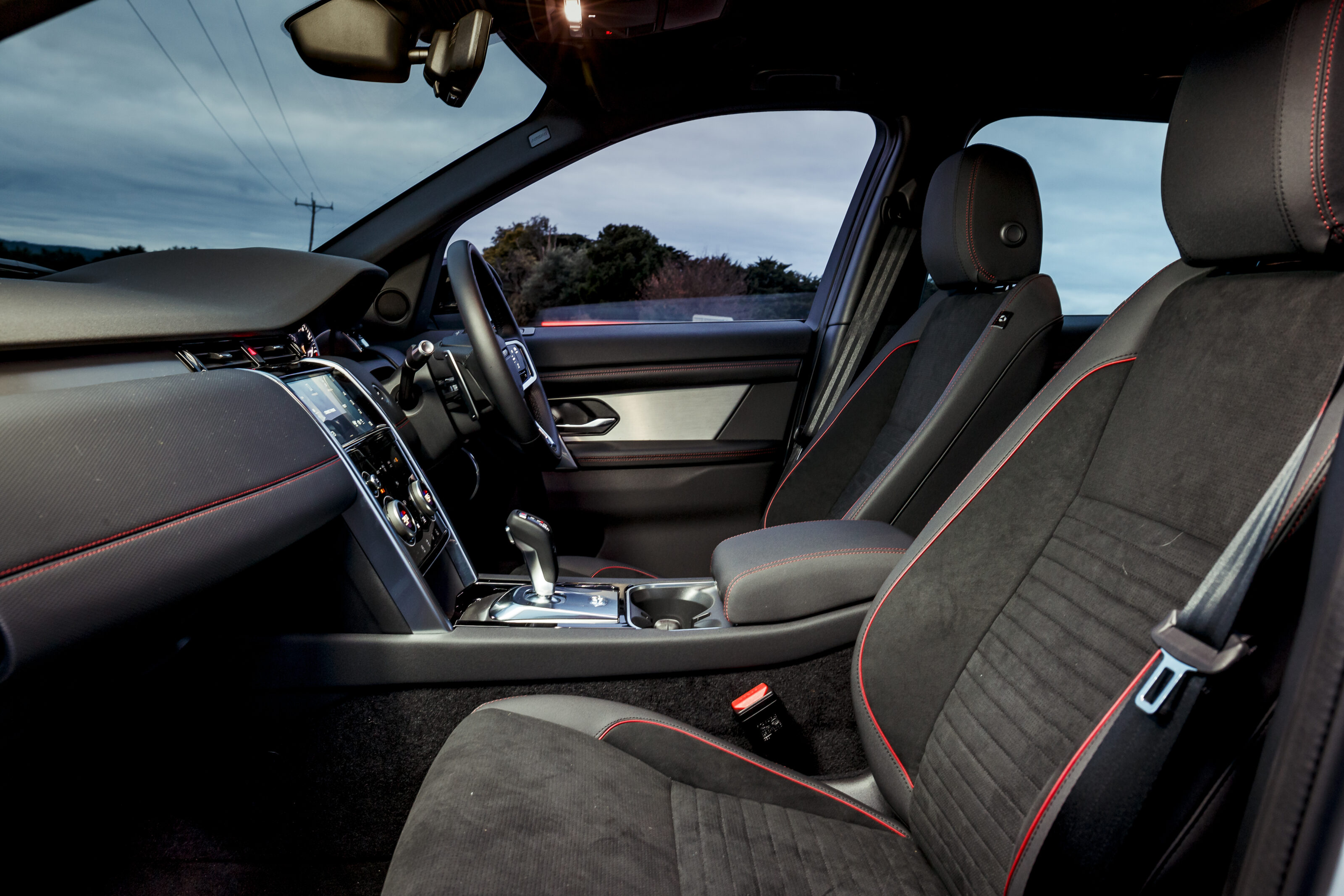
The steering wheel controls are easy to use once you’ve figured out what they actually do – since, in an effort to make them look cleaner, JLR has omitted any clues as to their functionality – as is the elegant and simple centre console. This features just two large rotary knobs for adjusting the climate and driving modes while on the go, alongside a select few other touch-sensitive buttons.
Most of the cabin is designed intuitively, including the armrest which is set at a good height and can be manually altered to find that sweet spot for your elbow.
But the window controls sit on top of the door card right next to the windows themselves, which feels odd – you have to stretch and it diverts your attention away rather than letting your fingers find the buttons easily while you focus on the road. Interestingly, on JLR’s more upmarket F-Pace, the controls are back down in the traditional position. Go figure.
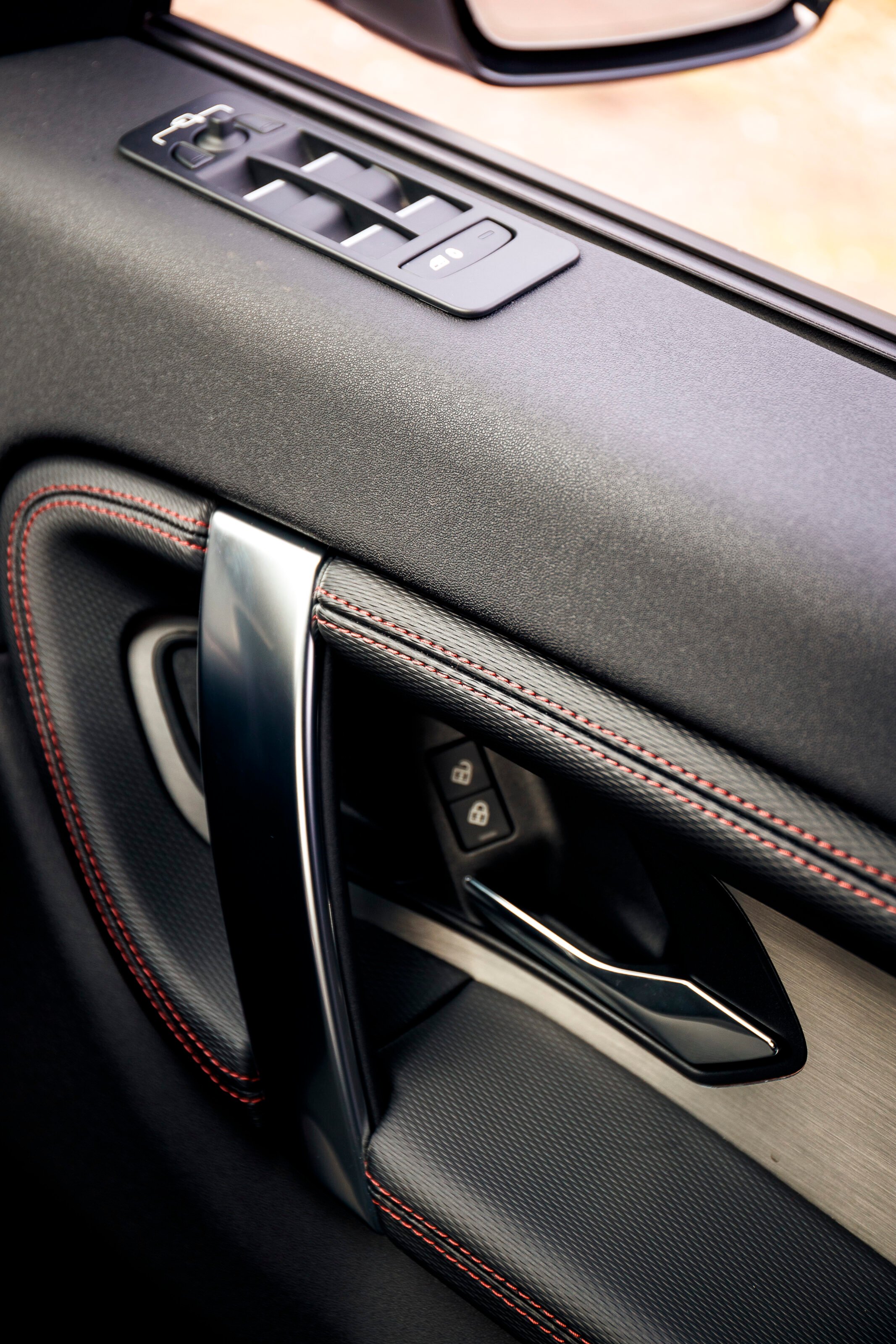
Other handy features include a powered tailgate, again useful for dropping kids off at childcare or school with a million and one things in your hands (most often including them when they refuse to walk by themselves).
One nice-to-have inclusion which isn’t standard on this model is privacy glass to keep the winter or summer sun out of little people’s eyes. Although this is often a costed option on most cars, there’s something to be said for expecting a little more from a premium offering.
While you might accept paying extra for it on a volume-selling mid-sized SUV, we feel for almost three times the price you could get a little more bang for your buck. Same goes for heated seats – as a minimum on the Disco Sport these will cost $810 more.

Speaking of extras, and there are a lot, this particular base-level example has some options fitted to bump the user experience up a notch. A wireless charging pad will set you back $150, although we’d probably not bother until wireless Apple CarPlay/Android Auto comes into the mix – what’s the point of wireless charging if you have to plug your phone in to use its functions anyway?
However, it does have the ability for two phones to connect via Bluetooth at once, as well as a mix of USB and USB-C ports across all rows as standard.
The clever Clearsight rearview mirror is a worthy add-on if you’re consistently carrying tall people in the back or want to ferry around lots of luggage. It costs $980 and uses a wide-angle camera on the roof to project a crisp image onto the mirror of what’s behind the vehicle when it would otherwise be obscured.
Our test car also had premium mats for $460 – although we couldn’t quite figure out what exactly made them so ‘premium’ as they didn’t look any different to ordinary floor mats. Many families would probably opt for rubber inserts if they have young children, not fancy but very practical.
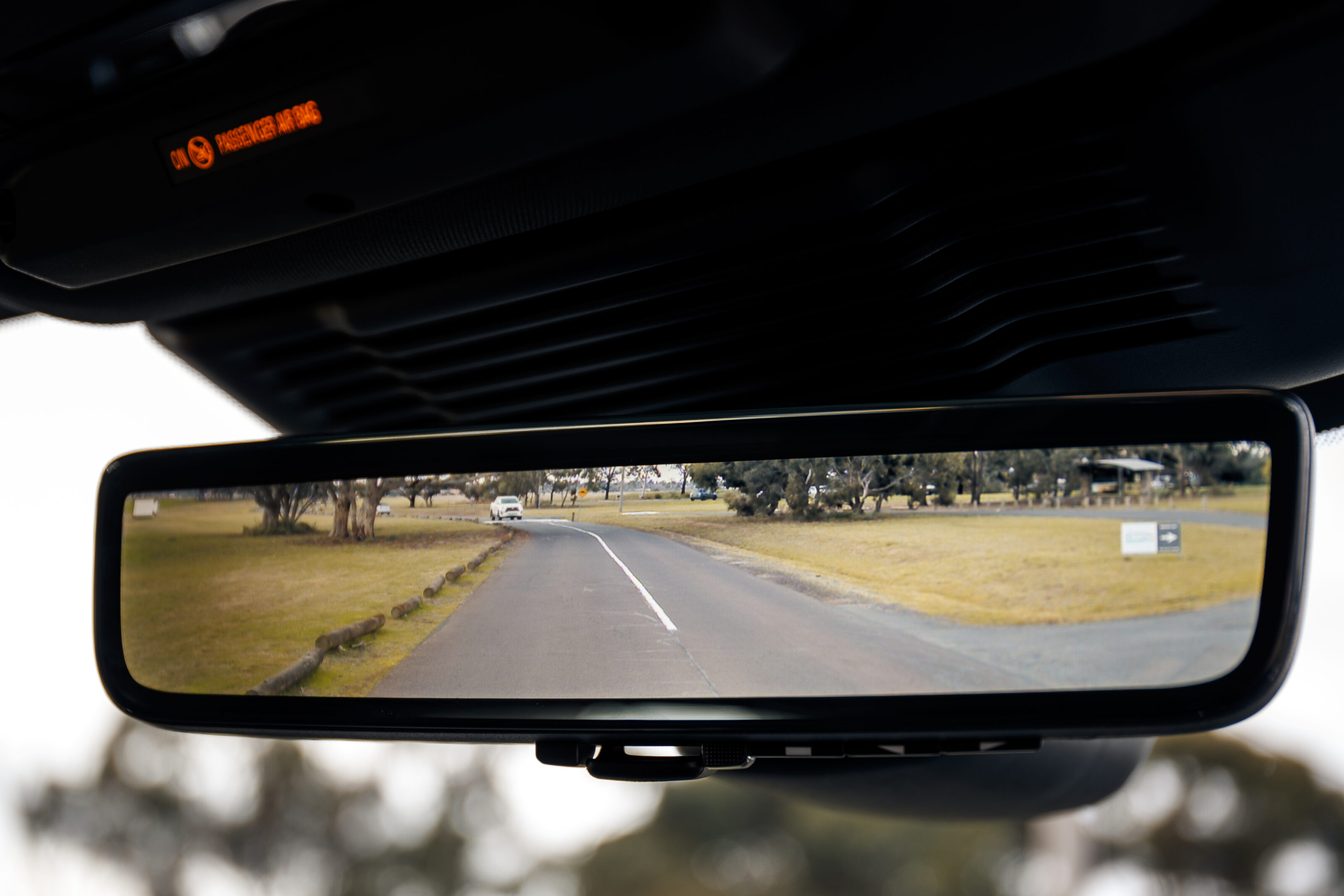
Now for the good stuff. We were mildly obsessed with the optional cabin air filtration system (+$780). It automatically gets rid of fine particulate matter, allergens, pollen (useful for hay fever sufferers) and even bad smells. The central touchscreen displays air quality readings inside and out, while a meter rates it from ‘good’ to ‘hazardous’.
It was fascinating to see how staggeringly different the air quality was in metropolitan Melbourne compared to regional Victoria, and again how it changed in the presence of someone having a bonfire locally. Be warned, though, it can have you reaching for the ‘purify’ button as much as you would the volume dial as you try to chase down the cleanest air possible.
One nice-to-have inclusion which isn’t standard on this model is privacy glass. Although this is often a costed option on most cars, there’s something to be said for expecting a little more from a premium offering.
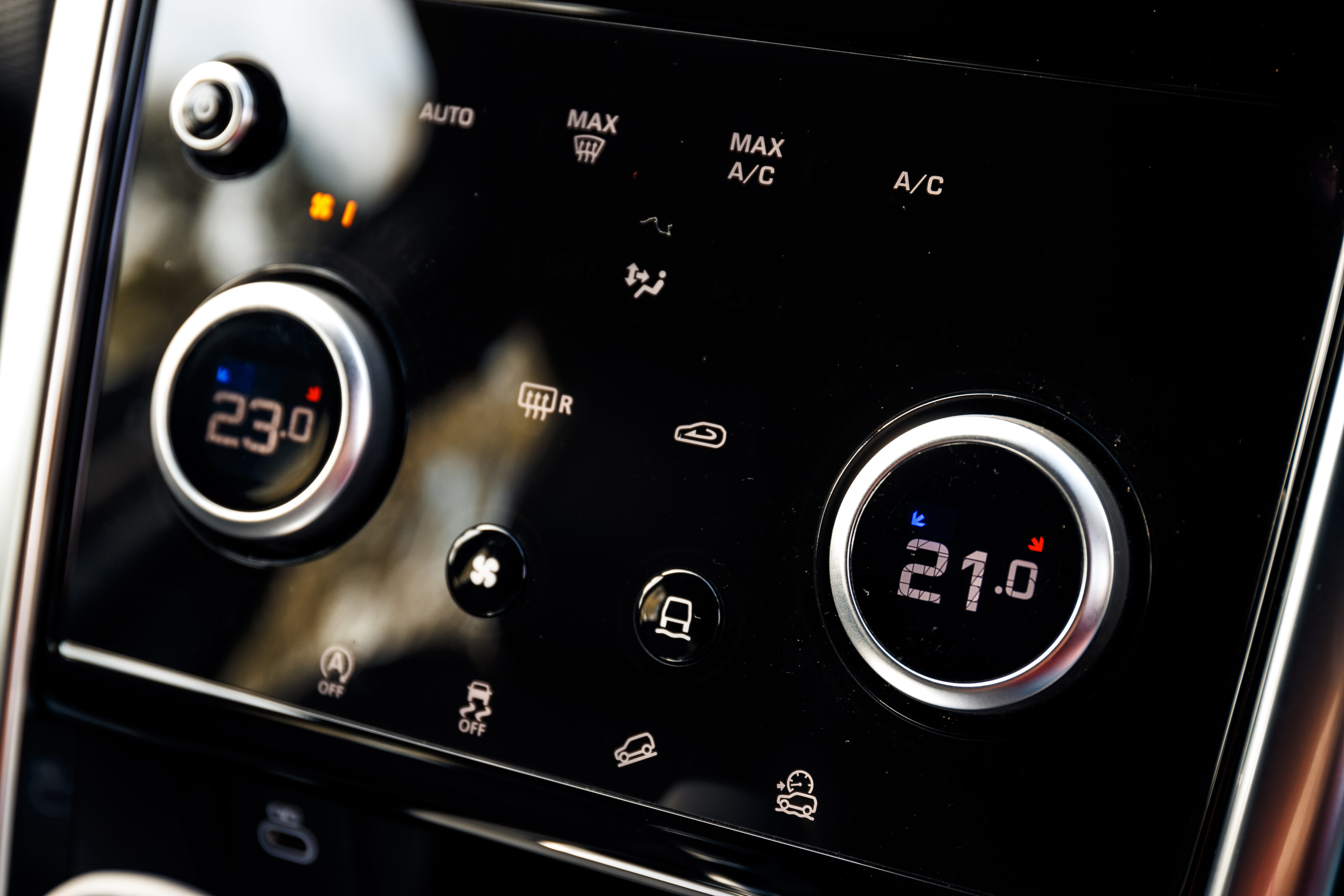
A real highlight is the 3D surround camera, plus its new rear traffic and rear collision monitors. While cheaper SUVs have reversing cameras of varying qualities, the 3D experience here is just next level.
You can choose which corner of the car you want to check the blind spots on and swipe the touchscreen in any direction to give a full bird’s-eye view of its surroundings.
This is great news when it comes to common danger zones where being even more aware of where small children might be wandering is no bad thing. Using it in the kindy car park and outside a local school, it more than proved its worth.
Equally, having a 360 view brings added reassurance you’re not scuffing those 18-inch, five-split-spoke alloys. Although you’d be fairly hard pushed to do so as they’re wrapped in chunky 235/60 Michelin Latitude tyres.
We’ve got to slam the brakes on you here, though, for some bad news – the MY22 does not come with the 3D surround camera as standard. It is a $500 option on the P200, or more for higher-spec variants. Worth the $500 we’d say, but disappointing that it has been relegated to the options list for the latest model.
Comfort and space

Topping off our favourite features of this car has to be the boot space. A 5+2 premium compact SUV, it has 157L with all seven seats up, increasing to 1036L with the third row down which is ample boot space (and enough to change a toddler comfortably as it has no lip). Capacity increases to a massive 1651L with all but the front row folded flat.
The driver and front passenger seats are electrically adjustable, while the second row can also be moved manually and even recline, which makes hanging out in the back that bit more comfortable and enjoyable.
There are no cupholders or USB ports as standard, but the rear occupants do benefit from their own two-zone climate control vents and a centre armrest if there’s no one in the middle seat.
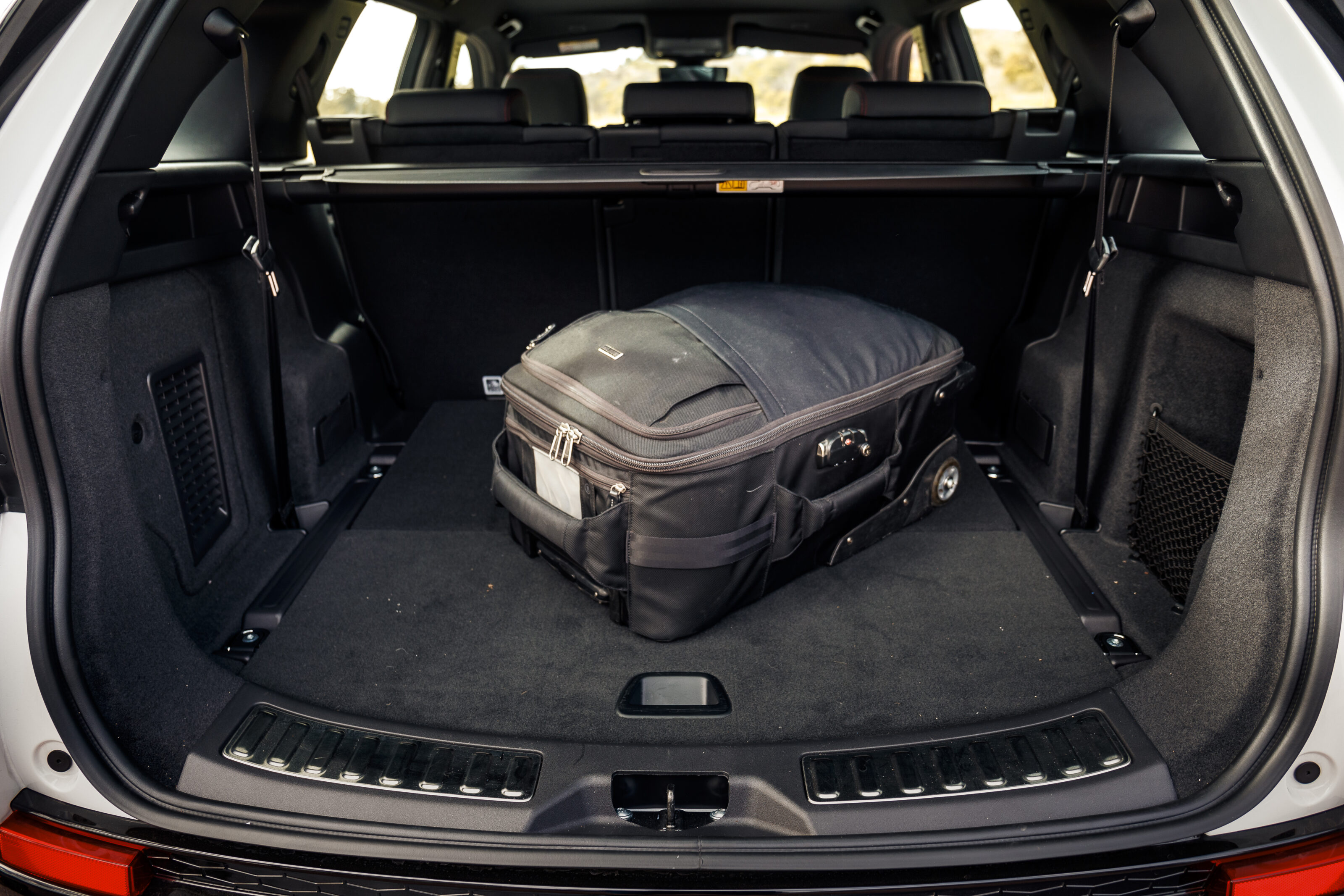
The third row, however – introduced as standard in 2020 – is a nice-to-have for when you’re on designated-driver duties carting your mates home from a night out, or ferrying your kids’ friends around, but they wouldn’t want to be spending any extended amount of time back there.
It’s not suitable for young children as there’s no ISOFIX or top-tether points for car seats, while a lack of legroom and general feeling of claustrophobia would probably make young ones over the age of 10 want to swap seats pretty sharpish.
On the upside, the side windows between the C and D pillar are quite large and do let in plenty of light.
Topping off our favourite features of this car has to be the boot space. As a 5+2 premium compact SUV, it has 157L with all seven seats up, increasing to 1036L with the third row down.
On the road
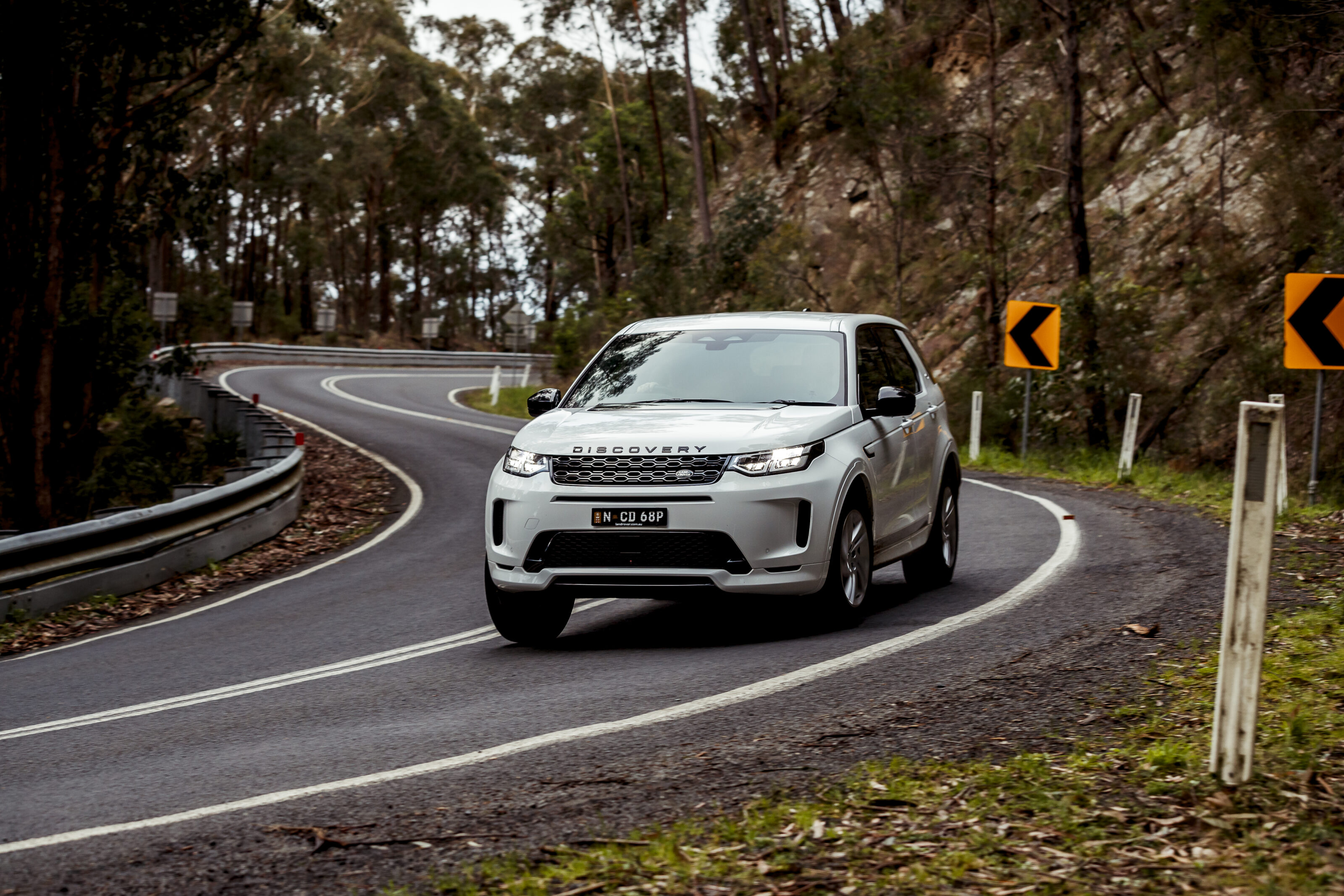
This 2021 Land Rover Discovery Sport R-Dynamic S P200 features a 2.0-litre Ingenium four-cylinder turbo-petrol engine mated to a nine-speed auto transmission sending 147kW/320Nm to all four wheels.
As outlined, though, there are diesels in the line-up, both 2.0-litre TD4s, offering either 120kW/380Nm for the S D165 or 150kW/430Nm for the SE D200. The mid-range petrol SE P250 and range-topping HSE P250 both churn out 183kW/365Nm.
Driving around town, the P200 is smooth, comfortable and very quiet. The ride can be a little bumpy on particularly bad roads, but for the most part it’s well-composed, especially given the car is on coil springs and lacks adaptive dampers. Engine noise is very well suppressed too.
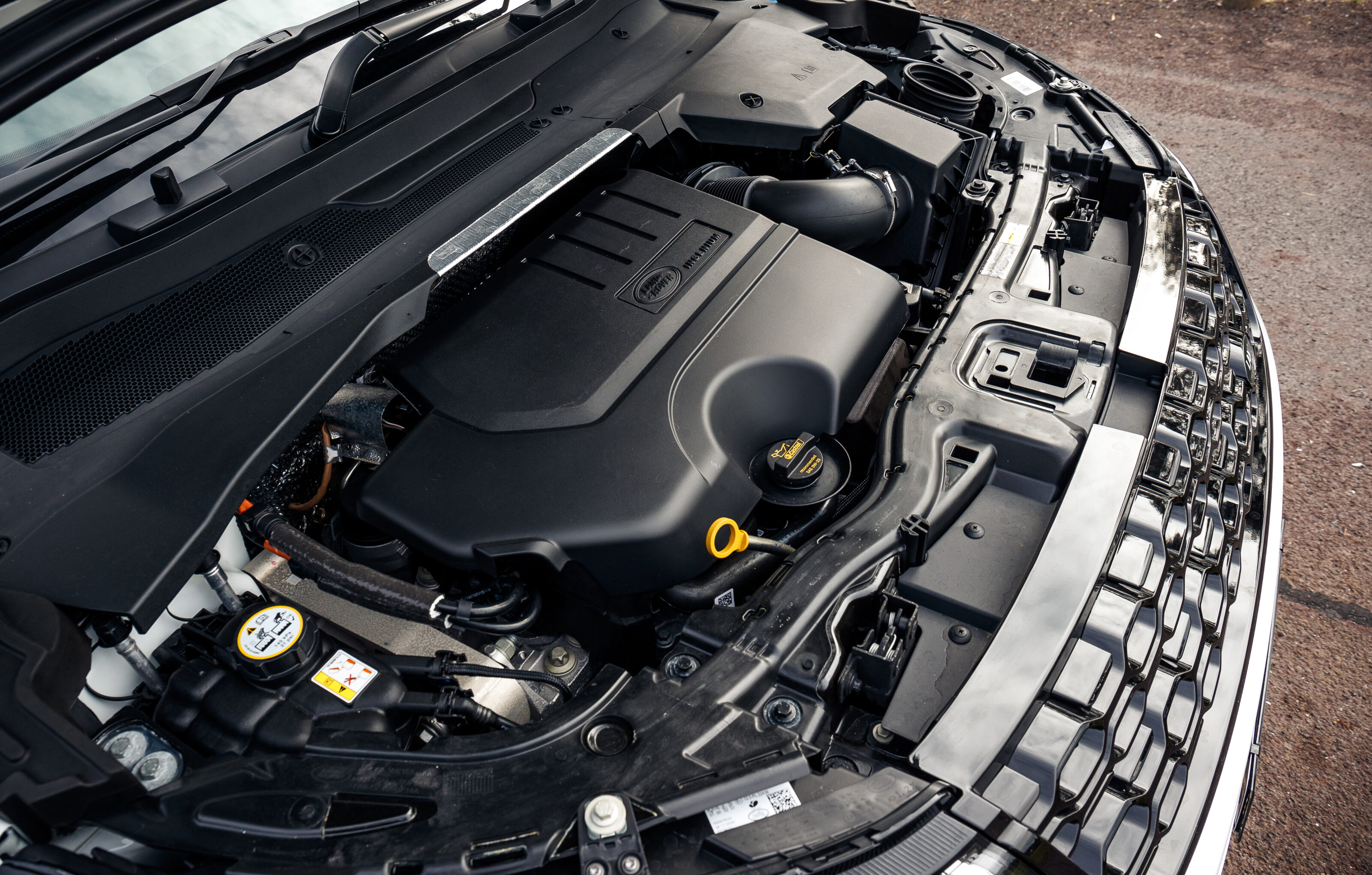
While its low-end response is healthy, rolling acceleration isn’t quite as strong as it could be, which could be an issue in certain situations such as a freeway overtake. Consider one of the higher-spec engines offering stronger performance if this is a requirement.
The Disco Sport particularly feels the strain when in Eco mode, which can be lethargic when you put your foot down. I found it’s best to stay in the Auto drive mode.
Body control is good through the corners, and the steering is fluid and nicely weighted, although it’s let down by a slight dead spot just off-centre. The brakes are also strong and responsive with a nice pedal feel.
Meanwhile, the shifter is a little slow to respond when parking/reversing off a driveway/executing a three-point turn – requiring far too deliberate an effort. Despite this, it’s a pretty smooth cruiser and the metal paddle-shifters are a classy touch if you ever get bored of letting the car do all the work.
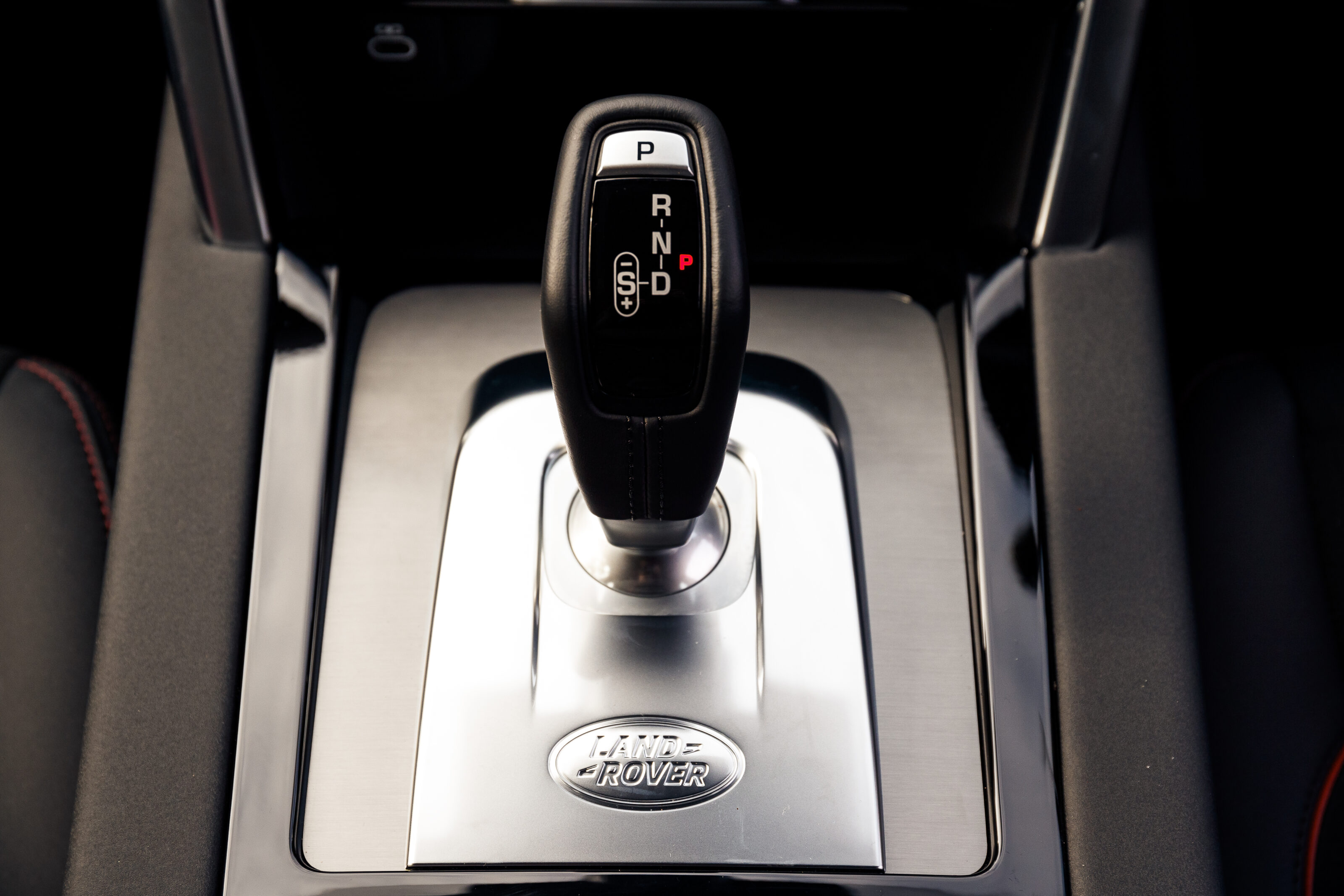
Off-road the Disco Sport is much more capable than you might imagine for a luxury SUV, thanks, in large part, to its ClearSight Ground View function introduced in 2019. This incredibly clever camera tech stitches together images below the bonnet for enhanced visibility.
A raft of dedicated driving modes can also be toggled via the rotary knob on the centre stack in addition to the go-to auto setting. In fact, just about any terrain has its own setting, as you can choose between rock crawl, grass, gravel and snow, mud and ruts and even a sand mode.
The Disco Sport wasn’t with us long enough to give a proper idea of its fuel consumption. But with a lot of mixed driving – freeway, town and twisty roads in the hills – we found the average we managed was 10.8L/100km. However this could probably be bettered in eco mode to bring it closer to its official rating of 8.1L/100km.
Off-road the Disco Sport is much more capable than you might imagine for a luxury SUV, thanks, in large part, to its ClearSight Ground View feature.
Safety

As standard, the MY21 Land Rover Discovery Sport gets a raft of new advanced driver assistance features, including automatic braking and rear traffic monitoring.
There’s also clear exit monitoring on the rear doors, blind-spot assist, adaptive cruise control, lane-keep assist, rear collision monitoring, traffic sign recognition with adaptive speed limiter and wade sensing, as well as driver condition monitoring.
Ownership
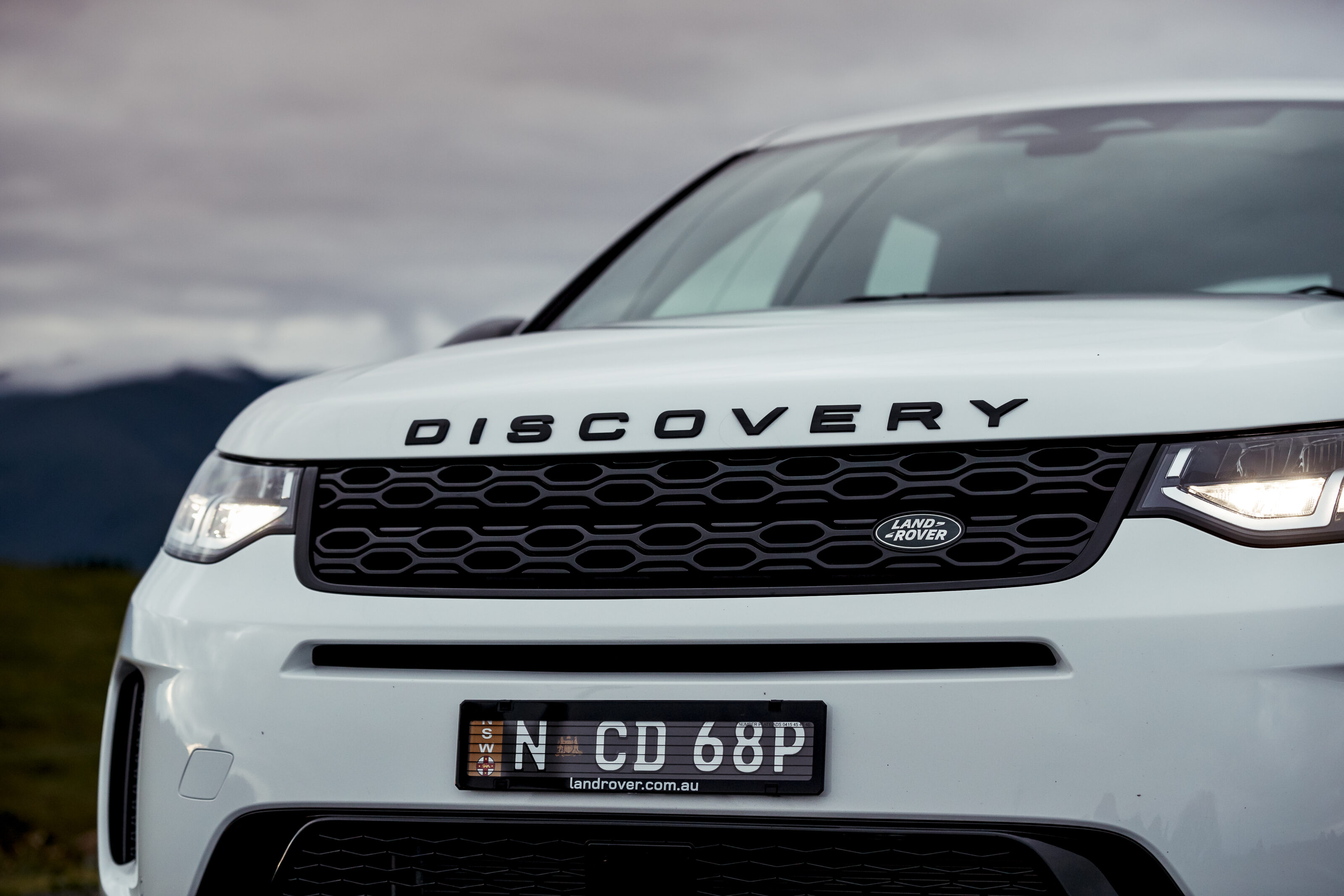
Like all Jaguar Land Rover products since April this year, the Discovery Sport comes with a five-year/unlimited-kilometre warranty, which includes paint protection on the same terms, while bodywork corrosion is covered for six years.
To its credit, JLR is only the second premium brand to join the wider market in offering five years of coverage, with Mercedes-Benz taking the leap in 2020. Lexus already offered four years, but BMW and Audi appear content (and claim their customers are as well) with three-year terms.
VERDICT

The Disco Sport is undoubtedly a great family car, and in P200 guise with a few options such as the Clearsight rearview mirror and cabin air filtration system, it represents good value.
If you want or need more power and torque, the mid-range petrol SE P250 and range-topping HSE P250 both turn out 183kW/365Nm, or if fuel economy is the more important factor, the S D165 and SE D200 both offer 5.7/100km.
The P200 we’ve tested is up $5200 on the MY20 model, but is $1110 cheaper than the incoming MY22.
Compared to its closest rivals, the Disco Sport is good value in its segment, especially given the extra two seats available – a USP among its rivals.

Compared to its closest rivals, the BMW X3 that retails at $84,828 before on-roads, and the Audi Q5 which costs $77,000, and not to forget its Range Rover Evoque cousin coming it in $74,907, the Disco Sport is good value in its segment, especially given the extra two seats available – a unique selling point among its rivals.
Other rivals you could consider, which are more affordable, are the VW Tiguan Allspace and Skoda Kodiaq that cost between $40K and $50K before on-roads and options. The Mercedes-Benz GLB 200 is also worth mentioning here as it starts from around $60K before ORC.
Overall, we’d pick to stay with the MY21 update over the new MY22. While it’s nice to have the very latest offering, the 2021 model is cheaper than its successor and a lot of standard features, including the 3D surround camera, have disappointingly been relegated to the options list for the new car. Your money will go further with the MY21, and for us, that’s what counts.
2021 Land Rover Discovery Sport R-Dynamic S P200 specifications
| Body | Five-door 5+2 medium SUV |
|---|---|
| Drive | Front-wheel drive |
| Engine | 2.0-litre Ingenium four-cylinder turbo-petrol |
| Transmission | Nine-speed automatic |
| Power | 147kW |
| Torque | 320Nm |
| Bore/Stroke | N/A |
| Compression ratio | N/A |
| 0-100km/h | 9.2 sec |
| Fuel consumption | 8.1L/100km |
| Weight | 1979kg |
| Suspension | Coil suspension |
| L/W/h | 4597/1904/1725mm |
| Wheelbase | 2741mm |
| Brakes | 349mm (front); 325mm (rear) |
| Tyres | 235/60 Michelin Latitude tyres |
| Wheels | 18-inch five-split-spoke alloys |
| Price | $65,700 + ORC |
Score breakdown
Things we like
- Lots of boot space – especially with third row down
- Smooth and comfortable drive
- 3D surround camera
Not so much
- Some options should be standard
- Transmission slow to react to input
- Third row a bit claustrophobic


